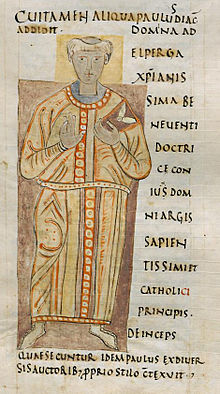Paul the Deacon

Paul the Deacon (c. 720s – 13 April in 796, 797, 798, or 799 AD), also known as Paulus Diaconus, Warnefridus, Barnefridus, or Winfridus, and sometimes
.Life
An ancestor of Paulus's named Leupichis emigrated to Italy in 568 in the train of
Thanks to the possible noble status of his family, Paul received an exceptionally good education, probably at the court of the Lombard king Ratchis in Pavia, learning the rudiments of Greek from a teacher named Flavian. Paul was probably the secretary of the Lombard king Desiderius, a successor of Ratchis. After Desiderius's daughter Adelperga had married Arichis II, duke of Benevento, Paul, at her request, wrote his continuation of Eutropius's Summary of Roman History (Latin: Breviarium Historiae Romanae).[1]
He lived at the court of
After Paul's literary achievements had drawn the attention of Charlemagne, he became an important contributor to the Carolingian Renaissance. In 787 he returned to Monte Cassino, where he died on 13 April probably in the year 799.[2] His epithet Diaconus indicates that he took orders as a deacon; and some believe he was a monk before the fall of the Lombard Kingdom.[1]
Works
Paul's chief work is his
The region of the north, in proportion as it is removed from the heat of the sun and is chilled with snow and frost, is so much the more healthful to the bodies of men and fitted for the propagation of nations, just as, on the other hand, every southern region, the nearer it is to the heat of the sun, the more it abounds in diseases and is less fitted for the bringing up of the human race.[1]
Among Paul's sources were the document called the
Related to his history of the Langobards is Paul's Historia Romana; this is a continuation of
At the request of
While Paul was in Francia, Charlemagne asked him to compile a collection of
A life of Pope Gregory the Great has also been attributed to Paul,[4] and he is credited with a Latin translation of the Greek Life of Saint Mary the Egyptian.[8]
Notes
- ^ a b c d e f g h Chisholm 1911, p. 964.
- ^ a b Schlager, Patricius. "Paul the Deacon." The Catholic Encyclopedia Vol. 11. New York: Robert Appleton Company, 1911. 8 June 2023
 This article incorporates text from this source, which is in the public domain.
This article incorporates text from this source, which is in the public domain.
- OCLC 29531520.
- ^ a b Chisholm 1911, p. 965.
- ^ Lyons 2007, p. 223.
- ISBN 978-0521031998. Retrieved 22 Aug 2016.
- ^ Francesco Lepore, La Virgo Mirabilis in Paolo Diacono. Spunti di riflessione mariana tra admiratio, invocatio e imitatio, in "Theotokos", 16/1 (2008): pp. 231–243.
- ISBN 978-0859915687. Retrieved 22 Aug 2016.
References
- Lyons, Stuart (2007). Horace's Odes and the Mystery of Do-Re-Mi. Oxford: Oxbow Books. ISBN 978-0-85668-790-7.
Attribution:
- This article incorporates text from a publication now in the public domain: Chisholm, Hugh, ed. (1911). "Paulus Diaconus". Encyclopædia Britannica. Vol. 20 (11th ed.). Cambridge University Press. pp. 964–965. Endnotes:
- Carlo Cipolla, Note bibliografiche circa l'odierna condizione degli studi critici sul testo delle opere di Paolo Diacono (Venice, 1901)
- Atti e memorie del congresso storico tenuto in Cividale (Udine, 1900)
- Felix Dahn, Langobardische Studien, Bd. i. (Leipzig, 1876)
- Wilhelm Wattenbach, Deutschlands Geschichtsquellen, Bd. i. (Berlin, 1904)
- Albert Hauck, Kirchengeschichte Deutschlands, Bd. ii. (Leipzig, 1898)
- Pasquale Del Giudice [it], Studi di storia e diritto (Milan, 1889)
![]() This article incorporates text from a publication now in the public domain: Herbermann, Charles, ed. (1913). "Paul the Deacon". Catholic Encyclopedia. New York: Robert Appleton Company.
This article incorporates text from a publication now in the public domain: Herbermann, Charles, ed. (1913). "Paul the Deacon". Catholic Encyclopedia. New York: Robert Appleton Company.
Further reading
- Goffart, Walter (1988). The Narrators of Barbarian History. Yale.
- Paul the Deacon (2013). Liber de episcopis Mettensibus. Dallas Medieval Texts and Translations. Vol. 19. Translated by Kempf, Damien. Paris/Leuven/Walpole, MA: Peeters. Archived from the original on 2018-01-14. Retrieved 2018-01-13.
- Christopher Heath (2017) The Narrative Worlds of Paul the Deacon: Between Empires and Identities in Lombard Italy (Amsterdam: Amsterdam University Press}
